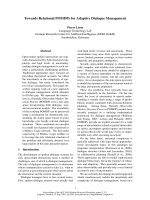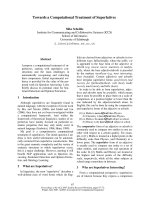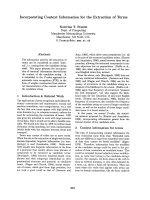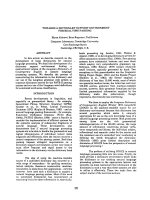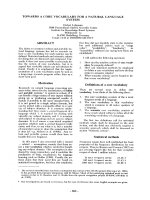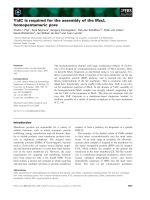Báo cáo khoa học: "Towards a Framework for Abstractive Summarization of Multimodal Documents" pot
Bạn đang xem bản rút gọn của tài liệu. Xem và tải ngay bản đầy đủ của tài liệu tại đây (227.27 KB, 6 trang )
Proceedings of the ACL-HLT 2011 Student Session, pages 75–80,
Portland, OR, USA 19-24 June 2011.
c
2011 Association for Computational Linguistics
Towards a Framework for
Abstractive Summarization of Multimodal Documents
Charles F. Greenbacker
Dept. of Computer & Information Sciences
University of Delaware
Newark, Delaware, USA
Abstract
We propose a framework for generating an ab-
stractive summary from a semantic model of a
multimodal document. We discuss the type of
model required, the means by which it can be
constructed, how the content of the model is
rated and selected, and the method of realizing
novel sentences for the summary. To this end,
we introduce a metric called information den-
sity used for gauging the importance of con-
tent obtained from text and graphical sources.
1 Introduction
The automatic summarization of text is a promi-
nent task in the field of natural language processing
(NLP). While significant achievements have been
made using statistical analysis and sentence extrac-
tion, “true abstractive summarization remains a re-
searcher’s dream” (Radev et al., 2002). Although
existing systems produce high-quality summaries of
relatively simple articles, there are limitations as to
the types of documents these systems can handle.
One such limitation is the summarization of mul-
timodal documents: no existing system is able to in-
corporate the non-text portions of a document (e.g.,
information graphics, images) into the overall sum-
mary. Carberry et al. (2006) showed that the con-
tent of information graphics is often not repeated
in the article’s text, meaning important information
may be overlooked if the graphical content is not in-
cluded in the summary. Systems that perform statis-
tical analysis of text and extract sentences from the
original article to assemble a summary cannot access
the information contained in non-text components,
let alone seamlessly combine that information with
the extracted text. The problem is that information
from the text and graphical components can only be
integrated at the conceptual level, necessitating a se-
mantic understanding of the underlying concepts.
Our proposed framework enables the genera-
tion of abstractive summaries from unified semantic
models, regardless of the original format of the in-
formation sources. We contend that this framework
is more akin to the human process of conceptual in-
tegration and regeneration in writing an abstract, as
compared to the traditional NLP techniques of rat-
ing and extracting sentences to form a summary.
Furthermore, this approach enables us to generate
summary sentences about the information collected
from graphical formats, for which there are no sen-
tences available for extraction, and helps avoid the
issues of coherence and ambiguity that tend to affect
extraction-based summaries (Nenkova, 2006).
2 Related Work
Summarization is generally seen as a two-phase pro-
cess: identifying the important elements of the doc-
ument, and then using those elements to construct
a summary. Most work in this area has focused on
extractive summarization, assembling the summary
from sentences representing the information in a
document (Kupiec et al., 1995). Statistical methods
are often employed to find key words and phrases
(Witbrock and Mittal, 1999). Discourse structure
(Marcu, 1997) also helps indicate the most impor-
tant sentences. Various machine learning techniques
have been applied (Aone et al., 1999; Lin, 1999), as
well as approaches combining surface, content, rel-
75
evance and event features (Wong et al., 2008).
However, a few efforts have been directed to-
wards abstractive summaries, including the modifi-
cation (i.e., editing and rewriting) of extracted sen-
tences (Jing and McKeown, 1999) and the genera-
tion of novel sentences based on a deeper under-
standing of the concepts being described. Lexical
chains, which capture relationships between related
terms in a document, have shown promise as an in-
termediate representation for producing summaries
(Barzilay and Elhadad, 1997). Our work shares sim-
ilarities with the knowledge-based text condensation
model of Reimer and Hahn (1988), as well as with
Rau et al. (1989), who developed an information ex-
traction approach for conceptual information sum-
marization. While we also build a conceptual model,
we believe our method of construction will produce
a richer representation. Moreover, Reimer and Hahn
did not actually produce a natural language sum-
mary, but rather a condensed text graph.
Efforts towards the summarization of multimodal
documents have included na
¨
ıve approaches relying
on image captions and direct references to the im-
age in the text (Bhatia et al., 2009), while content-
based image analysis and NLP techniques are being
combined for multimodal document indexing and
retrieval in the medical domain (N
´
ev
´
eol et al., 2009).
3 Method
Our method consists of the following steps: building
the semantic model, rating the informational con-
tent, and generating a summary. We construct the
semantic model in a knowledge representation based
on typed, structured objects organized under a foun-
dational ontology (McDonald, 2000). To analyze the
text, we use Sparser,
1
a linguistically-sound, phrase
structure-based chart parser with an extensive and
extendible semantic grammar (McDonald, 1992).
For the purposes of this proposal, we assume a rela-
tively complete semantic grammar exists for the do-
main of documents to be summarized. In the proto-
type implementation (currently in progress), we are
manually extending an existing grammar on an as-
needed basis, with plans for large-scale learning of
new rules and ontology definitions as future work.
Projects like the Never-Ending Language Learner
1
/>(Carlson et al., 2010) may enable us to induce these
resources automatically.
Although our framework is general enough to
cover any image type, as well as other modalities
(e.g., audio, video), since image understanding re-
search has not yet developed tools capable of ex-
tracting semantic content from every possible im-
age, we must restrict our focus to a limited class of
images for the prototype implementation. Informa-
tion graphics, such as bar charts and line graphs, are
commonly found in popular media (e.g., magazines,
newspapers) accompanying article text. To integrate
this graphical content, we use the SIGHT system
(Demir et al., 2010b) which identifies the intended
message of a bar chart or line graph along with other
salient propositions conveyed by the graphic. Ex-
tending the prototype to incorporate other modalities
would not entail a significant change to the frame-
work. However, it would require adding a module
capable of mapping the particular modality to its un-
derlying message-level semantic content.
The next sections provide detail regarding the
steps of our method, which will be illustrated on
a short article from the May 29, 2006 edition of
Businessweek magazine entitled, “Will Medtronic’s
Pulse Quicken?”
2
This particular article was chosen
due to good coverage in the existing Sparser gram-
mar for the business news domain, and because it ap-
pears in the corpus of multimodal documents made
available by the SIGHT project.
3.1 Semantic Modeling
Figure 1 shows a high-level (low-detail) overview
of the type of semantic model we can build using
Sparser and SIGHT. This particular example mod-
els the article text (including title) and line graph
from the Medtronic article. Each box represents
an individual concept recognized in the document.
Lines connecting boxes correspond to relationships
between concepts. In the interest of space, the in-
dividual attributes of the model entries have been
omitted from this diagram, but are available in Fig-
ure 2, which zooms into a fragment of the model
showing the concepts that are eventually rated most
salient (Section 3.2) and selected for inclusion in
2
Available at />magazine/content/06_22/b3986120.htm.
76
Company1
StockPriceChange1
Idiom1
BeatForecast1
EarningsForecast1
EarningsReport1
Group2
Prediction2
MakeAnnouncement1
AmountPerShare1
AmountPerShare2
WhQuestion1
Group3
Comparison3
RevenuePct1
Market2
RevenuePct1 Company3
Comparison1
GrowthSlowed1Market1
MissForecast1SalesForecast1
Comparison2 CounterArgument1
MarketFluctuations1 Protected1
EarningsForecast2
AmountPerShare3
EarningsForecast3
AmountPerShare4
SalesForecast2
SalesForecast3
StockOwnership1Company4
EmployedAt1
EarningsGrowth1
Prediction4
Prediction3
Person2
GainMarketShare1
StockRating2
HistoricLow1
Group1
Prediction1
Person1
EmployedAt1
Company2
StockRating1
TargetStockPrice1
AmountPerShare2
StockPriceChange3
StockPriceChange2
LineGraph1
Volatile1
ChangeTrend1
AmountPerShare5
AmountPerShare6
AmountPerShare7
Figure 1: High-level overview of semantic model for Medtronic article.
the summary (Section 3.3). The top portion of each
box in Figure 2 indicates the name of the conceptual
category (with a number to distinguish between in-
stances), the middle portion shows various attributes
of the concept with their values, and the bottom por-
tion contains some of the original phrasings from
the text that were used to express these concepts
(formally stored as a synchronous TAG) (McDon-
ald and Greenbacker, 2010)). Attribute values in an-
gle brackets (<>) are references to other concepts,
hash symbols (#) refer to a concept or category that
has not been instantiated in the current model, and
each expression is preceded by a sentence tag (e.g.,
“P1S4” stands for “paragraph 1, sentence 4”).
P1S1: "medical device
giant Medtronic"
P1S5: "Medtronic"
Name: "Medtronic"
Stock: "MDT"
Industry: (#pacemakers,
#defibrillators,
#medical devices)
Company1
P1S4: "Investment firm
Harris Nesbitt's
Joanne Wuensch"
P1S7: "Wuensch"
FirstName: "Joanne"
LastName: "Wuensch"
Person1
P1S4: "a 12-month
target of 62"
Person: <Person 1>
Company: <Company 1>
Price: $62.00
Horizon: #12_months
TargetStockPrice1
Figure 2: Detail of Figure 1 showing concepts rated most
important and selected for inclusion in the summary.
As illustrated in this example, concepts conveyed
by the graphics in the document can also be included
in the semantic model. The overall intended mes-
sage (ChangeTrend1) and additional propositions
(Volatile1, StockPriceChange3, etc.) that SIGHT
extracts from the line graph and deems important
are added to the model produced by Sparser by sim-
ply inserting new concepts, filling slots for existing
concepts, and creating new connections. This way,
information gathered from both text and graphical
sources can be integrated at the conceptual level re-
gardless of the format of the source.
3.2 Rating Content
Once document analysis is complete and the seman-
tic model has been built, we must determine which
concepts conveyed by the document and captured
in the model are most salient. Intuitively, the con-
cepts containing the most information and having
the most connections to other important concepts in
the model are those we’d like to convey in the sum-
mary. We propose the use of an information den-
sity metric (ID) which rates a concept’s importance
based on a number of factors:
3
• Completeness of attributes: the concept’s
filled-in slots (f ) vs. its total slots (s) [“satura-
tion level”], and the importance of the concepts
(c
i
) filling these slots [a recursive value]:
f
s
∗ log(s) ∗
f
i=1
ID(c
i
)
3
The first three factors are similar to the dominant slot
fillers, connectivity patterns, and frequency criteria described
by Reimer and Hahn (1988).
77
• Number of connections/relationships (n) with
other concepts (c
j
), and the importance of these
connected concepts [a recursive value]:
n
j=1
ID(c
j
)
• Number of expressions (e) realizing the con-
cept in the current document
• Prominence based on document and rhetorical
structure (W
D
& W
R
), and salience assessed
by the graph understanding system (W
G
)
Saturation refers to the level of completeness with
which the knowledge base entry for a given concept
is “filled-out” by information obtained from the doc-
ument. As information is collected about a concept,
the corresponding slots in its concept model entry
are assigned values. The more slots that are filled,
the more we know about a given instance of a con-
cept. When all slots are filled, the model entry for
that concept is “complete,” at least as far as the on-
tological definition of the concept category is con-
cerned. As saturation level is sensitive to the amount
of detail in the ontology definition, this factor must
be normalized by the number of attribute slots in its
definition, thus log(s) above.
In Figure 3 we can see an example of relative
saturation level by comparing the attribute slots for
Company2 with that of Company1 in Figure 2.
Since the “Stock” slot is filled for Medtronic and
remains empty for Harris Nesbitt, we say that the
concept for Company1 is more saturated (i.e., more
complete) than that of Company2.
P1S4: "Investment firm
Harris Nesbitt"
Name: "Harris Nesbitt"
Stock:
Industry: (#investments)
Company2
Figure 3: Detail of Figure 1 showing example concept
with unfilled attribute slot.
Document and rhetorical structure (W
D
and W
R
)
take into account the location of a concept within
a document (e.g., mentioned in the title) and the
use of devices highlighting particular concepts (e.g.,
juxtaposition) in computing the overall ID score.
For the intended message and informational proposi-
tions conveyed by the graphics, the weights assigned
by SIGHT are incorporated into ID as W
G
.
After computing the ID of each concept, we will
apply Demir’s (2010a) graph-based ranking algo-
rithm to select items for the summary. This algo-
rithm is based on PageRank (Page et al., 1999), but
with several changes. Beyond centrality assessment
based on relationships between concepts, it also in-
corporates apriori importance nodes that enable us
to capture concept completeness, number of expres-
sions, and document and rhetorical structure. More
importantly from a generation perspective, Demir’s
algorithm iteratively selects concepts one at a time,
re-ranking the remaining items by increasing the
weight of related concepts and discounting redun-
dant ones. Thus, we favor concepts that ought to be
conveyed together while avoiding redundancy.
3.3 Generating a Summary
After we determine which concepts are most im-
portant as scored by ID, the next step is to de-
cide what to say about them and express these el-
ements as sentences. Following the generation tech-
nique of McDonald and Greenbacker (2010), the ex-
pressions observed by the parser and stored in the
model are used as the “raw material” for express-
ing the concepts and relationships. The two most
important concepts as rated in the semantic model
built from the Medtronic article would be Company1
(“Medtronic”) and Person1 (“Joanne Wuensch,” a
stock analyst). To generate a single summary sen-
tence for this document, we should try to find some
way of expressing these concepts together using the
available phrasings. Since there is no direct link
between these two concepts in the model (see Fig-
ure 1), none of the collected phrasings can express
both concepts at the same time. Instead, we need to
find a third concept that provides a semantic link be-
tween Company1 and Person1. If multiple options
are available, deciding which linking concept to use
becomes a microplanning problem, with the choice
depending on linguistic constraints and the relative
importance of the applicable linking concepts.
In this example, a reasonable selection would be
TargetStockPrice1 (see Figure 1). Combining orig-
inal phrasings from all three concepts (via substi-
tution and adjunction operations on the underlying
TAG trees), along with a “built-in” realization inher-
ited by the TargetStockPrice category (a subtype of
Expectation – not shown in the figure), produces a
78
construction resulting in this final surface form:
Wuensch expects a 12-month target of 62
for medical device giant Medtronic.
Thus, we generate novel sentences, albeit with some
“recycled” expressions, to form an abstractive sum-
mary of the original document.
Studies have shown that nearly 80% of human-
written summary sentences are produced by a cut-
and-paste technique of reusing original sentences
and editing them together in novel ways (Jing and
McKeown, 1999). By reusing selected short phrases
(“cutting”) coupled together with generalized con-
structions (“pasting”), we can generate abstracts
similar to human-written summaries.
The set of available expressions is augmented
with numerous built-in schemas for realizing com-
mon relationships such as “is-a” and “has-a,” as
well as realizations inherited from other concep-
tual categories in the hierarchy. If the knowledge
base persists between documents, storing the ob-
served expressions and making them available for
later use when realizing concepts in the same cat-
egory, the variety of utterances we can generate is
increased. With a sufficiently rich set of expres-
sions, the reliance on straightforward “recycling” is
reduced while the amount of paraphrasing and trans-
formation is increased, resulting in greater novelty
of production. By using ongoing parser observations
to support the generation process, the more the sys-
tem “reads,” the better it “writes.”
4 Evaluation
As an intermediate evaluation, we will rate the con-
cepts stored in a model built only from text and use
this rating to select sentences containing these con-
cepts from the original document. These sentences
will be compared to another set chosen by traditional
extraction methods. Human judges will be asked
to determine which set of sentences best captures
the most important concepts in the document. This
“checkpoint” will allow us to assess how well our
system identifies the most salient concepts in a text.
The summaries ultimately generated as final out-
put by our prototype system will be evaluated
against summaries written by human authors, as
well as summaries created by extraction-based sys-
tems and a baseline of selecting the first few sen-
tences. For each comparison, participants will be
asked to indicate a preference for one summary
over another. We propose to use preference-strength
judgment experiments testing multiple dimensions
of preference (e.g., accuracy, clarity, completeness).
Compared to traditional rating scales, this alterna-
tive paradigm has been shown to result in better
evaluator self-consistency and high inter-evaluator
agreement (Belz and Kow, 2010). This allows a
larger proportion of observed variations to be ac-
counted for by the characteristics of systems under-
going evaluation, and can result in a greater number
of significant differences being discovered.
Automatic evaluation, though desirable, is likely
unfeasible. As human-written summaries have only
about 60% agreement (Radev et al., 2002), there is
no “gold standard” to compare our output against.
5 Discussion
The work proposed herein aims to advance the state-
of-the-art in automatic summarization by offering a
means of generating abstractive summaries from a
semantic model built from the original article. By
incorporating concepts obtained from non-text com-
ponents (e.g., information graphics) into the seman-
tic model, we can produce unified summaries of
multimodal documents, resulting in an abstract cov-
ering the entire document, rather than one that ig-
nores potentially important graphical content.
Acknowledgments
This work was funded in part by the National Insti-
tute on Disability and Rehabilitation Research (grant
#H133G080047). The author also wishes to thank
Kathleen McCoy, Sandra Carberry, and David Mc-
Donald for their collaborative support.
References
Chinatsu Aone, Mary E. Okurowski, James Gorlinsky,
and Bjornar Larsen. 1999. A Trainable Summarizer
with Knowledge Acquired from Robust NLP Tech-
niques. In Inderjeet Mani and Mark T. Maybury, edi-
tors, Advances in Automated Text Summarization. MIT
Press.
Regina Barzilay and Michael Elhadad. 1997. Using lex-
ical chains for text summarization. In In Proceedings
79
of the ACL Workshop on Intelligent Scalable Text Sum-
marization, pages 10–17, Madrid, July. ACL.
Anja Belz and Eric Kow. 2010. Comparing rating
scales and preference judgements in language evalu-
ation. In Proceedings of the 6th International Natural
Language Generation Conference, INLG 2010, pages
7–16, Trim, Ireland, July. ACL.
Sumit Bhatia, Shibamouli Lahiri, and Prasenjit Mitra.
2009. Generating synopses for document-element
search. In Proceeding of the 18th ACM Conference
on Information and Knowledge Management, CIKM
’09, pages 2003–2006, Hong Kong, November. ACM.
Sandra Carberry, Stephanie Elzer, and Seniz Demir.
2006. Information graphics: an untapped resource for
digital libraries. In Proceedings of the 29th Annual
International ACM SIGIR Conference on Research
and Development in Information Retrieval, SIGIR ’06,
pages 581–588, Seattle, August. ACM.
Andrew Carlson, Justin Betteridge, Bryan Kisiel, Burr
Settles, Estevam R. Hruschka Jr., and Tom M.
Mitchell. 2010. Toward an architecture for never-
ending language learning. In Proceedings of the 24th
Conference on Artificial Intelligence (AAAI 2010),
pages 1306–1313, Atlanta, July. AAAI.
Seniz Demir, Sandra Carberry, and Kathleen F. Mc-
Coy. 2010a. A discourse-aware graph-based content-
selection framework. In Proceedings of the 6th In-
ternational Natural Language Generation Conference,
INLG 2010, pages 17–26, Trim, Ireland, July. ACL.
Seniz Demir, David Oliver, Edward Schwartz, Stephanie
Elzer, Sandra Carberry, and Kathleen F. McCoy.
2010b. Interactive SIGHT into information graphics.
In Proceedings of the 2010 International Cross Dis-
ciplinary Conference on Web Accessibility, W4A ’10,
pages 16:1–16:10, Raleigh, NC, April. ACM.
Hongyan Jing and Kathleen R. McKeown. 1999. The
decomposition of human-written summary sentences.
In Proceedings of the 22nd Annual International ACM
SIGIR Conference on Research and Development in
Information Retrieval, SIGIR ’99, pages 129–136,
Berkeley, August. ACM.
Julian Kupiec, Jan Pedersen, and Francine Chen. 1995.
A trainable document summarizer. In Proceedings
of the 18th Annual International ACM SIGIR Confer-
ence on Research and Development in Information Re-
trieval, SIGIR ’95, pages 68–73, Seattle, July. ACM.
Chin-Yew Lin. 1999. Training a selection function for
extraction. In Proceedings of the 8th International
Conference on Information and Knowledge Manage-
ment, CIKM ’99, pages 55–62, Kansas City, Novem-
ber. ACM.
Daniel C. Marcu. 1997. The Rhetorical Parsing, Summa-
rization, and Generation of Natural Language Texts.
Ph.D. thesis, University of Toronto, December.
David D. McDonald and Charles F. Greenbacker. 2010.
‘If you’ve heard it, you can say it’ - towards an ac-
count of expressibility. In Proceedings of the 6th In-
ternational Natural Language Generation Conference,
INLG 2010, pages 185–190, Trim, Ireland, July. ACL.
David D. McDonald. 1992. An efficient chart-based
algorithm for partial-parsing of unrestricted texts. In
Proceedings of the 3rd Conference on Applied Natural
Language Processing, pages 193–200, Trento, March.
ACL.
David D. McDonald. 2000. Issues in the repre-
sentation of real texts: the design of KRISP. In
Lucja M. Iwa
´
nska and Stuart C. Shapiro, editors, Nat-
ural Language Processing and Knowledge Represen-
tation, pages 77–110. MIT Press, Cambridge, MA.
Ani Nenkova. 2006. Understanding the process of multi-
document summarization: content selection, rewrite
and evaluation. Ph.D. thesis, Columbia University,
January.
Aur
´
elie N
´
ev
´
eol, Thomas M. Deserno, St
´
efan J. Darmoni,
Mark Oliver G
¨
uld, and Alan R. Aronson. 2009. Nat-
ural language processing versus content-based image
analysis for medical document retrieval. Journal of the
American Society for Information Science and Tech-
nology, 60(1):123–134.
Lawrence Page, Sergey Brin, Rajeev Motwani, and Terry
Winograd. 1999. The pagerank citation ranking:
Bringing order to the web. Technical Report 1999-
66, Stanford InfoLab, November. Previous number:
SIDL-WP-1999-0120.
Dragomir R. Radev, Eduard Hovy, and Kathleen McKe-
own. 2002. Introduction to the special issue on sum-
marization. Computational Linguistics, 28(4):399–
408.
Lisa F. Rau, Paul S. Jacobs, and Uri Zernik. 1989. In-
formation extraction and text summarization using lin-
guistic knowledge acquisition. Information Process-
ing & Management, 25(4):419 – 428.
Ulrich Reimer and Udo Hahn. 1988. Text condensation
as knowledge base abstraction. In Proceedings of the
4th Conference on Artificial Intelligence Applications,
CAIA ’88, pages 338–344, San Diego, March. IEEE.
Michael J. Witbrock and Vibhu O. Mittal. 1999. Ultra-
summarization: a statistical approach to generating
highly condensed non-extractive summaries. In Pro-
ceedings of the 22nd Annual International ACM SIGIR
Conference on Research and Development in Informa-
tion Retrieval, SIGIR ’99, pages 315–316, Berkeley,
August. ACM.
Kam-Fai Wong, Mingli Wu, and Wenjie Li. 2008.
Extractive summarization using supervised and semi-
supervised learning. In Proceedings of the 22nd Int’l
Conference on Computational Linguistics, COLING
’08, pages 985–992, Manchester, August. ACL.
80



